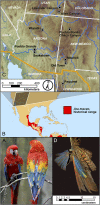Early procurement of scarlet macaws and the emergence of social complexity in Chaco Canyon, NM
- PMID: 26100874
- PMCID: PMC4500242
- DOI: 10.1073/pnas.1509825112
Early procurement of scarlet macaws and the emergence of social complexity in Chaco Canyon, NM
Abstract
High-precision accelerator mass spectrometer (AMS) (14)C dates of scarlet macaw (Ara macao) skeletal remains provide the first direct evidence from Chaco Canyon in northwestern New Mexico that these Neotropical birds were procured from Mesoamerica by Pueblo people as early as ∼ A.D. 900-975. Chaco was a prominent prehistoric Pueblo center with a dense concentration of multistoried great houses constructed from the 9th through early 12th centuries. At the best known great house of Pueblo Bonito, unusual burial crypts and significant quantities of exotic and symbolically important materials, including scarlet macaws, turquoise, marine shell, and cacao, suggest societal complexity unprecedented elsewhere in the Puebloan world. Scarlet macaws are known markers of social and political status among the Pueblos. New AMS (14)C-dated scarlet macaw remains from Pueblo Bonito demonstrate that these birds were acquired persistently from Mesoamerica between A.D. 900 and 1150. Most of the macaws date before the hypothesized apogeal Chacoan period (A.D. 1040-1110) to which they are commonly attributed. The 10th century acquisition of these birds is consistent with the hypothesis that more formalized status hierarchies developed with significant connections to Mesoamerica before the post-A.D. 1040 architectural florescence in Chaco Canyon.
Keywords: Chaco Canyon; archaeology; scarlet macaws; sociopolitical complexity.
Conflict of interest statement
The authors declare no conflict of interest.
Figures






References
-
- Neitzel JE. The Chacoan regional system. In: Upham S, Lightfoot K, Jewett R, editors. The Sociopolitical Structure of Prehistoric Southwestern Societies. Westview; Boulder, CO: 1989. pp. 509–556.
-
- Vargas VD. 1995. Copper bell trade patterns in the prehispanic U.S. Southwest and northwest Mexico. Archaeological Series (Arizona State Museum, Tucson, AZ), No. 187.
-
- Vokes AW, Gregory DA. Exchange networks for exotic goods in the Southwest and Zuni’s place in them. In: Gregory DA, Wilcox DR, editors. Zuni Origins. Univ Arizona Press; Tucson, AZ: 2007. pp. 318–357.
-
- Hargrave LL. Anthropological Papers. No. 20 Univ Arizona Press; Tucson, AZ: 1970. Mexican macaws, comparative osteology and survey of remains from the Southwest.
Publication types
MeSH terms
Substances
Grants and funding
LinkOut - more resources
Full Text Sources
Other Literature Sources

